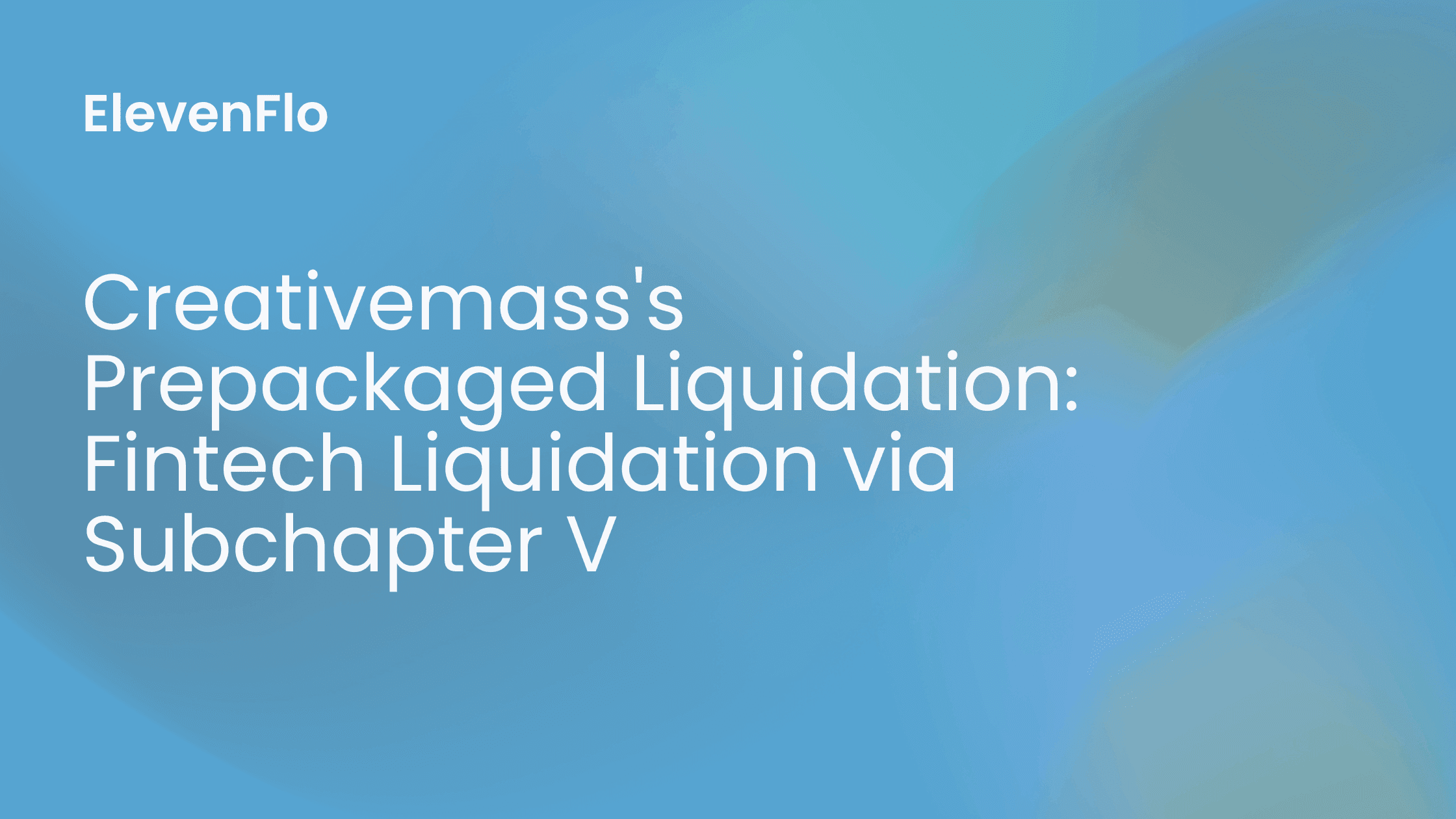Creativemass's Prepackaged Liquidation: Fintech Liquidation via Subchapter V

An in-depth look at Creativemass Holdings’ strategic Chapter 11 Subchapter V filing and its rapid fintech liquidation, featuring key sources on debt limits and Sub V’s evolving landscape.
A Fast-Tracked Fintech Liquidation
On April 14, 2025, Creativemass Holdings, Inc. and Creativemass Enterprises US LLC (together, the “Debtors”) filed a prepackaged Chapter 11 petition under Subchapter V in the District of Delaware (Case No. 25-10695). According to the Debtors’ First Day Declaration, they launched a vote on their liquidating plan on April 8, 2025, days after appointing Claudia Z. Springer as Chief Restructuring Officer. By employing Subchapter V’s streamlined procedures, Creativemass aims to cut administrative overhead, accelerate distributions, and avoid protracted litigation. Law360 (April 2025) notes that this approach could resolve creditor recoveries in mere weeks.
Global Growth to Insolvency
Creativemass launched in 2017 as a fintech venture centered on the WealthConnect™ platform, a Salesforce-integrated solution. Backed by $3.35 million in Series A funding from Republic Capital Group, the company rapidly scaled from 30 to over 220 employees, as its LinkedIn profile shows. Despite the initial momentum, a Financial Standard (May 2023) analysis highlights a broad decline in venture capital availability that left many fintech firms, including Creativemass, struggling to raise growth capital. An attempted $70 million round failed in late 2023, and the firm’s liquidity ran dry.
Complicating matters further, an unresolved R&D tax claim in Australia and a contentious $5.7 million Note-to-Equity Conversion, initiated in late 2022, provoked significant creditor disputes. This upheaval pushed the Australian subsidiary, Creativemass Enterprises Pty Ltd, into voluntary administration on March 15, 2023. Liquidators concluded there was no viable path to rescue. By early 2025, the U.S. entities had ceased operations, turning to bankruptcy counsel for a final wind-down. Ms. Springer, a Principal at Novo Advisors with over 40 years’ restructuring experience, stepped in to oversee an orderly liquidation process.
Why Subchapter V?
Subchapter V—enacted under the Small Business Reorganization Act of 2019—cuts costs relative to traditional Chapter 11 by dispensing with creditor committees, U.S. Trustee quarterly fees, and full-blown disclosure requirements. It also appoints a Subchapter V trustee with a facilitative (not managerial) role, as explained by the U.S. Trustee Program. Courts have largely embraced Subchapter V’s expedited confirmation timelines. Meanwhile, a White & Williams ABI Journal article (Feb. 2025) asserts that permanently raising the Subchapter V debt cap back to $7.5 million would expand access for distressed firms that exceed the now-reduced threshold. Notably, subchapter V accounted for 44% of all Chapter 11 cases at its peak, underscoring its growing influence.
Failed ABC Proceeding and the Delaware Filing
Before turning to federal court, Creativemass attempted an Assignment for the Benefit of Creditors (ABC) under Delaware law, but that proceeding failed on November 19, 2024 amid disputes regarding the Note-to-Equity Conversion. The Debtors then filed for Subchapter V relief on April 14, 2025, seeking immediate court supervision. Their proposed joint administration, granted under the same case number, streamlines docket management for both Creativemass Holdings, Inc. and Creativemass Enterprises US LLC. The bankruptcy court set a Confirmation Hearing for May 29, 2025, giving creditors until May 15, 2025 to object.
SBA Non-Voting Issues
A recurring concern in small business bankruptcies is the “silent class,” where government creditors (often the SBA) do not submit ballots. Bloomberg Law (Feb. 2025) discusses how non-voting can be treated as a rejection, potentially forcing a cramdown and deferring the debtors’ discharge until plan payments are completed. Although Creativemass does not appear to have significant SBA-held debt, this scenario underscores the importance of ensuring active creditor participation—particularly when a rapid liquidation is at stake.
Plan Highlights
Because Creativemass no longer operates, the proposed Plan focuses on an orderly dissolution and prompt creditor payouts. The First Day Declaration suggests that Unsecured Noteholders (Class 1.A) and General Unsecured Creditors (Class 1.B) may receive 100% on their allowed claims—a relatively strong outcome for a Chapter 11 scenario. Equity Interests (Class 2) are canceled but may share in leftover proceeds from the Australian liquidation if the Material Australian Dividend is sufficient. This arrangement—rare in a bankruptcy context—signals that most claimants stand to benefit from the prepackaged nature of the proceedings.
| Class | Treatment | Projected Recovery |
|---|---|---|
| 1.A - Unsecured Noteholders | Paid in Full (principal + accrued interest) | 100% |
| 1.B - General Unsecured Creditors | Paid in Full | 100% |
| 2 - Equity Holders | Canceled; partial payout if surplus remains | ~45% (estimated) |
First Day Relief and Path Forward
Standard “first day” relief granted by the court includes continued use of existing bank accounts and the retention of a claims agent to streamline notices, solicitations, and distributions. By merging the plan confirmation process with case commencement, Creativemass seeks to cut statutory delays. Should no major objections materialize, the court’s fast-track schedule could finalize plan confirmation before Q3 2025 ends, clearing the way for initial distributions soon thereafter.
Fintech and Subchapter V Trends
Creativemass Holdings’ Subchapter V case spotlights two pivotal forces: fintech’s heavy dependence on external capital and Subchapter V’s evolving debt limit debate. The Debtors’ collapse following VC setbacks mirrors the broader contraction in fintech funding, while the push to permanently restore the $7.5 million eligibility cap underscores the importance of Subchapter V for future distressed startups. Although this filing is a liquidation rather than a conventional rescue, its rapid, court-supervised wind-down affirms Subchapter V’s utility in delivering swift outcomes. If lawmakers reinstate the higher debt threshold, more small businesses could follow Creativemass’s path, benefiting from streamlined reorganization or liquidation.


